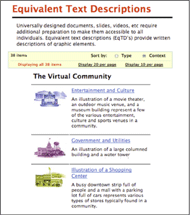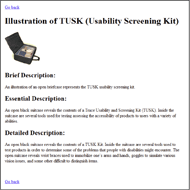Roger O. Smith, PhD, Tereza Snyder, BFA, Keith D. Edyburn, BSE, Aura M. Hirschman, MS
R2D2 Center, University of Wisconsin-Milwaukee
ABSTRACT
Information about Universal Design has exploded over the past decade: textbooks have proliferated on the topicof Universal Design, journal articles related to accessibilityhave become much more common, and the World Wide Web has grown into an indispensable source of information. Fortunately, this rapid expansion of information has been facilitated with a parallel improvement of information search tools such as Google, Google Scholar, and other library bibliographical search systems, including those specific to rehabilitation such as in the National Rehabilitation Information Center (NARIC, 2012). However, while all of these sources of information are constantly improving their search capabilities, the rapidly expanding availability of information related to universal design demands focused tools for finding the most pertinent information efficiently.
The ACCESS-Life websites created at the R2D2 Center at the University of Wisconsin- Milwaukee provide a centralized clearinghouse serving as an access point for information about universal design in higher education and in the community. Several key design features enable quick access, access by people with disabilities, rapid examination of larger sets of information, and elicitation of information user feedback on the helpfulness and quality of resources. This paper introduces the ACCESS- ed (http://access-ed.r2d2.uwm.edu/) and ACCESS-Main Street (http://access- mainstreet.r2d2.uwm.edu/) resource websites on universal design and describes several specific features. A new component of the websites demonstrates a moderation feature for sustainability and for the continual updating of resources based on the community of individuals interested in universal design in higher education and in our living communities.
OVERALL DESCRIPTION
While these websites have numerous content areas and unique elements, three key design features are highlighted here:
- The virtual environment website design and the other search strategies that include a custom user filtering mechanism,
- The Universal Design functionality, and
- The engagement of the user community and moderation design.
SEARCH MECHANISMS
First, the search system taps a database of over 700 resource entries selected and reviewed by our universal design resource team. These resources include primarily, other web pages and websites, but also catalogue downloadable documents from websites. The critical criteria for resource selection and inclusion are that the resource: a) focuses on universal design and is well written, b) is electronic and available from the worldwide web, and c) is free. This approach is intentionally biased against other resources that might be difficult to obtain or only obtainable with payment. To facilitate the search process, all entries have a written annotation. When a search is performed, these titles, annotations and sources are presented to assist the inquirer in making a quick decision whether they want to further pursue the resource or not.
 Figure 1: Search with roles for unregistered user d
Figure 1: Search with roles for unregistered user dThree primary search features have been designed (http://access- ed.r2d2.uwm.edu/Search_System/): 1) a free text search using the Google search engine, 2) a free text search specific to the data fields of the ACCESS-Life websites, 3) use of a visual virtual campus or community to prompt browsing.
 Figure 2: Search for registered user d
Figure 2: Search for registered user dBesides key words, entries are coded to various roles and interest areas to help focus the search and highlight salient information. An unregistered user may click a button to access the roles functionality on a per search basis, as seen in Figure 1. Registered users have the option of pulling roles from their profile rather than filling out roles for each search, as seen in Figure 2.
UNIVERSAL DESIGN FEATURES
 Figure 3: Equivalent Text Description list page d
Figure 3: Equivalent Text Description list page dWhile numerous, relatively standard universal design features are available on this website, such as variable font size, high contrast, and consistent locations of information, ACCESS-Life incorporates a full implementation of equivalent text descriptions through mouse-over labels (title text), alt-text, and long descriptions (longdesc). Uniquely, the ACCESS-Life website provides multi-level equivalent text descriptions and makes them available for all users, not only those accessing a screen reader, but for any other users. Figure 3 illustrates an excerpt from equivalent text description list page (http://access- ed.r2d2.uwm.edu/EqTDs/) and Figure 4 shows the design of the end point equivalent text description page for any particular graphic (e.g. http://access-ed.r2d2.uwm.edu/EqTD/tuskkit).
USER COMMUNITY PARTICIPATION
 Figure 4: Equivalent Text Description for a graphic d
Figure 4: Equivalent Text Description for a graphic dIn 2012, the Access-Life websites are implementing a new sustainability and community participation concept. The design of this website feature has a dual motivation. First, as grant-funded websites, maintaining them after grants end becomes an economic challenge. In anticipation of this, we are developing and testing a methodology to involve the community. We intend website users to not only provide feedback and highlight new resources, but new features allow committed and engaged users to edit existing resources as a type of ownership of these universal design websites. This user- participation feature includes three levels of involvement. The first is the website user who provides feedback or contributes ideas, such as nominating other resources which should be considered for inclusion on the websites. Figure 5 illustrates an excerpt of a user feedback page (http://access- ed.r2d2.uwm.edu/Form/Feedback). A website user can comment on any resource, rate the resource for its helpfulness and nominate new resources. The second level of participation are Moderators who are notified when new nominations or comments are entered onto the website. This prompts a Moderator to review the information and approve it so it can be formally posted. Lastly, a Moderator Supervisor oversees the Moderator level for a quick check and tuning before the entries or comments are posted. A full manual is available to registered Moderators and Supervisors. These provide step-by-step directions. The manual has been tested and validated through two internal testing procedures and is in the process of external testing.
To operationalize this participative website design, the underlying resource database structure and coding links the ACCESS-Ed and ACCESS-Main Street databases. The Django framework (https://www.djangoproject.com/) creates the administrative foundation for a back-end CMS used by the site developers with partial permissions allocated to Moderator and Moderator Supervisor levels.
IMPLICATIONS
The ACCESS-Life website spearheads several features important to the rehabilitation technology and universal design fields. ACCESS-Life serves as an exemplar website design features in four ways: 1) ACCESS-Life provides a foundational resource database on universal design unique to the field. 2) These websites facilitate easy search and access to over 700 universal design free resources. 3) The implementation of the universal design features and, in particular, the equivalent text descriptions provides an exemplar of how text information can be provided, not only for individuals who use screen readers, but other individuals who might need text provided for visual information in a universal format. 4) The ACCESS-Life websites advance a sustainability design based on active user participation.
REFERENCES
ACCESS-ed Equivalent Text Description. Retrieved January 16, 2012 from http://access- ed.r2d2.uwm.edu/EqTDs/
ACCESS-ed Example EqTD. Retrieved January 16, 2012 from http://access- ed.r2d2.uwm.edu/EqTD/tuskkit
ACCESS-ed Feedback Form. Retrieved January 16, 2012 from http://access- ed.r2d2.uwm.edu/Form/Feedback
ACCESS-ed Roles. Retrieved January 16, 2012 from http://access- mainstreet.r2d2.uwm.edu/Search/?show_roles =on
ACCESS-ed Search System. Retrieved January 16, 2012 from http://access- ed.r2d2.uwm.edu/search_system
ACCESS-ed Website. Retrieved January 16, 2012 from http://access-ed.r2d2.uwm.edu/
Access-Mainstreet Website. Retrieved January 16, 2012 from http://access- mainstreet.r2d2.uwm.edu/
Django Web Framework. Retrieved January 16, 2012 from https://www.djangoproject.com
NARIC Website. Retrieved January 16, 2012 from http://www.naric.com/
ACKNOWLEDGEMENTS
This work has been supported in part by the U.S. Department of Education's Office of Post- secondary Education, PR/Awards #P333A050090 and #P333A080071 and the Wisconsin Department of Health Services, on behalf of the division of Long Term Care, Office of Independence and Employment Pathways Medicaid Infrastructure Grant. The opinions contained in this paper do not necessarily represent the policy of the Department of Education, and you should not assume endorsement by the Federal Government.